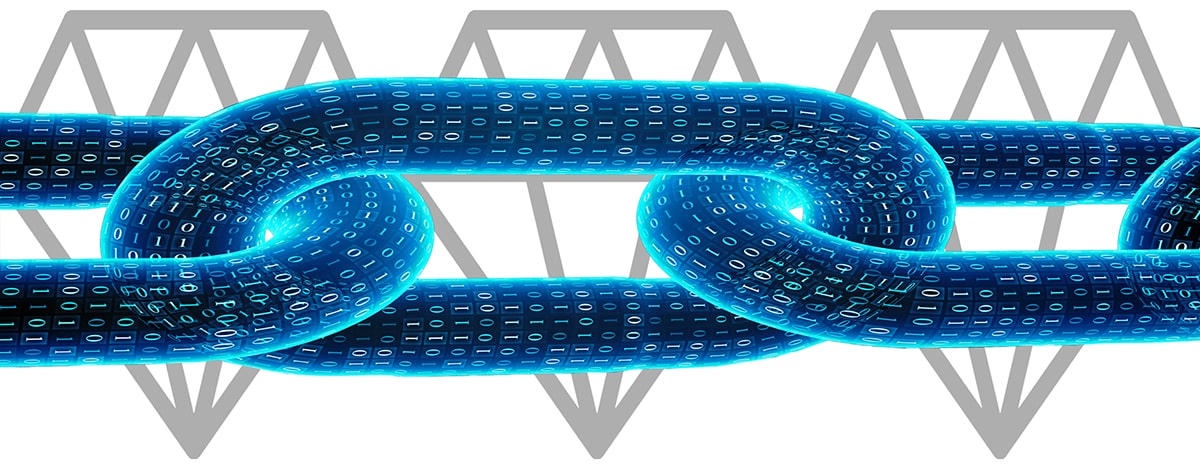BLOCKCHAIN, THE BARELY-UNDERSTOOD TECHNOLOGY
THAT IS CHANGING THE WORLD AND THE DIAMOND BUSINESS
Blockchain. It’s a technology that many believe will change the world as we know it, although few properly understand what it is exactly. It almost certainly will impact the diamond business, but in ways that are not fully realized at present.
To consider the possibilities, however, it is important first to qualify not only what blockchain is, but what it is not. For example, it is not as many believe a cryptocurrency, like Bitcoin, although it is the technology the facilitates the creation of alternative digital monetary systems.
In essence, a blockchain is a distributed and secure database that reliably records sequences of transactions, which cannot be edited or changed after a transaction has taken place. Security is maintained through cryptography, the accurate recording of the time each transaction is made, and the fact that it is peer-to-peer network, meaning that is managed autonomously and in a decentralized way. This means that no single person or body controls the information, which is transparent to all members of the network.
Using regular currency, for example, one can only verify that a transaction has taken place if it confirmed by an independent reference body, like a bank. With a cryptocurrency, blockchain records the transaction, making it transparent to all members of the network. This removes the need for a reference bank. Without blockchain, Bitcoin would not work.
DIGITAL LEDGER KEEPER AND CONFIRMING IDENTITY OF CORRESPONDING PARTY
The sharing of information through a decentralized online platform is not a new concept; after all, that is very the basis of the Internet. But when it comes to transferring objects with monetary value, we have continued to use old fashioned instruments. Even online payment methods like PayPal have required integration with a bank account or credit card.
Blockchain, with its ability to replace the services of a third-party reference, allows for the development of independent financial systems. By using your private key to access that the section of the blockchain that you own, you can effectively transfer all or part the value of whatever is stored in that section, which means that you are transferring the control over all or part of the information or data in your possession. This act is recorded, and the record is made public and cannot be deleted.
When users are issued with a blockchain address, they are also issued with a private key, which in the case of bitcoin is usually a 256-bit number. They can keep it secure by storing it on their computers on a disk that is encrypted. This means that blockchain also fills another role that traditionally was provided by the banks, and this is establishing the integrity of the corresponding party, before it allows a new block (or transaction) to be added to the chain. No one can edit a blockchain without having the correct corresponding keys.
Certain blockchains are public, meaning that they theoretically can be accessed by all, which would be a prerequisite, for example, for a universal currency, such as Bitcoin. Other are private, meaning that access requires an invitation that must be validated by either the network starter, or by a set of rules put in place by the network starter.
Also, not all the information that can be retrieved from a blockchain block needs to be stored on the system’s servers, requiring massive amounts of computing power, but can be linked to on other servers. This raises the possibility of many applications being created with blockchain as their foundation.
APPLYING BLOCKCHAIN IN THE DIAMOND BUSINESS
There are a range of possible applications for blockchain technology in the diamond sector, only some which involves use of cryptocurrencies. Indeed, there are already are growing number companies operating that accept digital currency as a form of payment, including MID House of Diamonds, which in 2017 first announced that it would begin accepting Bitcoin as payment from clients for diamond and jewelry purchases, becoming one of the world’s first gem dealers to recognize the cryptocurrency as legal tender.
Blockchain also has also been proposed as means for keeping track of diamonds in the pipeline that are serving as collateral for loans issued by financial institutions to the industry, without having to remove them from the production process. This could provide a solution for the severe lack of bank financing that currently is being experienced by smaller and medium-sized diamond companies.
One of the most important applications is likely to be blockchain technology that creates traceable and transparent supply chains, stretching literally from the from mine to the jewellery consumer. Every time the a gemstone, jewellery component or full item of jewellery changes hands, the transfer of ownership or custody is recorded as another block in the chain. By creating protocols with conditions that must be met before a transfer takes place, it would be possible to create rule-based systems that defend the integrity of the entire chain.
De Beers currently is developing an industry-wide blockchain that will track gems each time they change hands starting from the moment they are first mined. The company has promised that it will be would be open to everyone in the business and would offer the potential for monitoring each stone. It said that it envisions having an unbiased third-party organisation manage the project, and it will allow developers to build applications on top of it.
Other companies are also investigating Blockchain systems. They include Alrosa, which is reportedly also investigating a blockchain system with capabilities like those discussed by De Beers, and also the Canadian diamond miner Lucapa.
 Play Video about JOIN US AT THE DIAMOND SHOW - HONG KONG 16-20 SEPTEMBER 2024
Play Video about JOIN US AT THE DIAMOND SHOW - HONG KONG 16-20 SEPTEMBER 2024 Play Video about Gemgeneve2022- NOVEMBER
Play Video about Gemgeneve2022- NOVEMBER Play Video
Play Video






